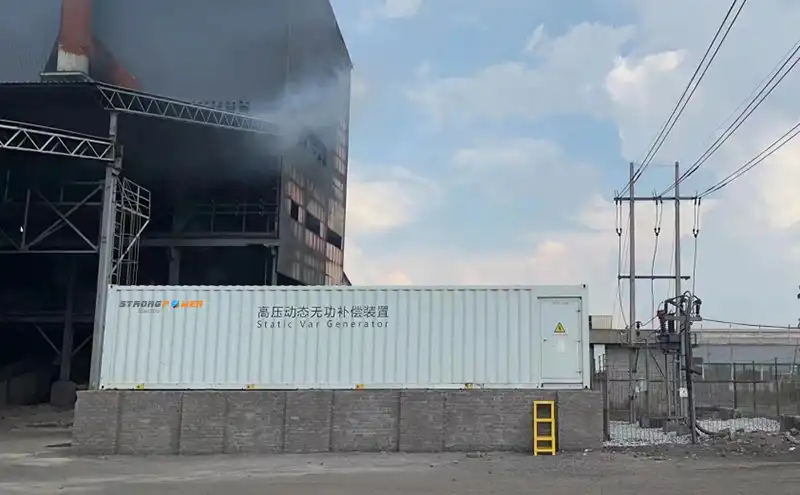Case Background:
The production line of a large metallurgical plant primarily consists of high-power nonlinear loads, including induction motors, arc furnaces, and rolling mills. These devices have led to two significant power quality issues: a chronically low power factor (averaging just 0.7) and severe harmonic pollution (with current distortion rates reaching 25% THDi). This operational condition creates multiple challenges: the plant faces penalty fees from the power grid company for poor power factor; harmonic-induced heating increases losses in transformers and cables; voltage waveform distortion interferes with sensitive control equipment; and most critically, the 5th and 7th characteristic harmonics risk triggering resonant conditions with system capacitors, posing a serious threat to equipment safety.
Solution:
To address this complex operational challenge, Strong Power implemented an innovative hybrid compensation system combining “SVG/STATCOM (Static Var Generator), FC (Fixed Capacitor bank), and active filtering technology.” Unlike conventional capacitor-based compensation methods that suffer from slow response times and potential harmonic amplification-induced resonance risks, this advanced solution features SVG/STATCOM as its dynamic compensation core. Utilizing a pq detection algorithm grounded in instantaneous reactive power theory, the SVG/STATCOM achieves rapid load variation tracking compensation within 10ms while maintaining real-time bus voltage stability. The integrated PWM converter in the SVG/STATCOM actively generates counter-phase harmonic currents, achieving over 85% filtration efficiency for dominant characteristic harmonics (5th, 7th, and 11th orders). Complementing this, the tuned fixed capacitor bank employs a 6% series reactance design to deliver fundamental reactive power compensation while preventing parallel resonance with system impedance.

The hybrid compensation system features the following topology: the grid busbar is connected in parallel with an SVG device, followed by a graded-switching fixed capacitor bank (FC), and ultimately linked to the load. In this configuration, the SVG handles dynamic regulation, while the FC automatically engages during stable load conditions to reduce SVG capacity demands and optimize operational costs. By employing an FFT-based harmonic detection algorithm and a coordinated control strategy, the system achieves reactive power compensation while simultaneously suppressing harmonics and preventing resonance risks.
In terms of harmonic control, this solution employs a multi-layered protection approach:
- Active Harmonic Compensation: The SVG’s active filtering function dynamically generates compensating currents by monitoring load harmonics in real time, effectively reducing THDi from 25% to below 4%.
- Detuned Reactor Protection: The FC branch incorporates a detuned reactor, ensuring inductive behavior at harmonic frequencies to prevent capacitor-induced harmonic amplification.
- Adaptive Control: An intelligent control system continuously tracks harmonic levels and dynamically adjusts the operation of both SVG and FC to mitigate resonance risks.
Result:
After the system’s implementation, it delivered outstanding results: the power factor consistently improved from 0.7 to 0.98, fully complying with grid assessment standards. Voltage fluctuations were significantly reduced from ±15% to ±2%, while transformer losses decreased by 60%. Additionally, harmonic distortion (THDi) was effectively controlled below 3%. Notably, the system eliminated the frequent resonance tripping issues of the original reactive compensation device, cutting annual fault downtime by 85%. Projected annual savings exceed 2 million yuan, with 30% attributed to reduced maintenance costs from harmonic suppression.
This case demonstrates that in demanding environments like the metallurgical industry—where reactive power demand is high, load fluctuations are rapid, and harmonic pollution is severe—the hybrid SVG+FC compensation system combined with active filtering achieves dual objectives: reactive compensation and harmonic control. This integrated approach not only resolves inefficiencies from low power factor but also enhances equipment longevity by improving power quality. As power electronics technology advances, such multifunctional systems—merging reactive compensation and active filtering—will see broader industrial adoption.



